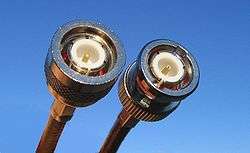TNC connector
The TNC connector (acronym of "Threaded Neill–Concelman") is a threaded version of the BNC connector.
 TNC connector on the left beside BNC. | |||
| Type | RF coaxial connector | ||
|---|---|---|---|
| Production history | |||
| Designer | Paul Neill and Carl Concelman | ||
| Designed | Late 1950s | ||
| Manufacturer | Various | ||
| General specifications | |||
| Diameter |
Male: 0.590 in (15.0 mm) Female: 0.378 in (9.6 mm) (outer, typical) Thread 7/16-28 UNEF | ||
| Cable | Coaxial | ||
| Passband | Typically 0–11 GHz | ||
Description
The interface specifications for the TNC and many other connectors are referenced in MIL-STD-348.[1] The connector has a 50 Ω impedance and operates best in the 0–11 GHz frequency spectrum. It has better performance than the BNC connector at microwave frequencies. Invented in the late 1950s and named after Paul Neill of Bell Labs and Carl Concelman of Amphenol, the TNC connector has been employed in a wide range of radio and wired applications.[2][3]
The abbreviation TNC is sometimes given as standing for Threaded Navy Connector.[4][5]
The TNC connector features a 7/16"-28 thread.[6]
Variations
Reverse-polarity TNC

Reverse-polarity TNC (RP-TNC, sometimes RTNC) is a variation of the TNC specification which reverses the polarity of the interface. This is usually achieved by incorporating the female contacts normally found in jacks into the plug, and the male contacts normally found in plugs into the jack.[7]
Because they were not readily available, RP-TNC connectors have been widely used by Wi-Fi equipment manufacturers to comply with specific local regulations, such as those from the FCC,[8] which are designed to prevent consumers from connecting antennas which exhibit gain and therefore breach compliance. The FCC considered that the RP-TNC was acceptable in preventing consumers changing the antenna; but by 2000 it regarded them as readily available,[9] though delaying its ruling indefinitely.[10] As of 2013, leading manufacturers are still using RP-TNC connectors on their Wi-Fi equipment.[11]
75 ohm TNC
Most TNC connectors are 50-ohm type even when used with coaxial cable of other impedances, but a 75-ohm series is also available, providing a good SWR to about 1 GHz.[12] These can be recognized by a reduced amount of dielectric in the mating ends. They are intermatable with standard types.
References
| Wikimedia Commons has media related to |
- RADIO FREQUENCY CONNECTOR INTERFACES FOR MIL-DTL-3643, MIL-DTL-3650, MIL-DTL-3655, MIL-DTL-25516, MIL-PRF-31031, MIL-PRF-39012, MIL-PRF-49142, MIL-PRF-55339, MIL-DTL-83517 (B with change 3 ed.). US DOD. 2017-01-22.
- E-Base Interactive. "TNC Connector Series". Amphenol RF. Retrieved 2011-01-12.
- "Electronic Warfare and Radar Systems Engineering Handbook". Microwaves101.com. Naval Air Systems Command. April 1999. pp. 1.15, 6.32. Retrieved 16 January 2017.
- Lange, K.; Locherer, K.-H., eds. (1986). Taschenbuch der Hochfrequenztechnik (4 ed.). Springer-Verlag. p. L10. ISBN 978-3-64296894-5. Retrieved 16 January 2017.
- Das, Annapurna; Das, Sisir K. Microwave Engineering (2000 ed.). New Delhi: Tata McGraw-Hill Publishing Company Ltd. p. 154. ISBN 0-07-463577-8. Retrieved 16 January 2017.
- http://www.wellshow.com/products/rf-connectors/tnc-connectors/
- "RP-TNC Connector".
- U.S. Code of Federal Regulations: 47 CFR 15.203, available at http://www.ecfr.gov
- FCC public notice, "OET clarifies antenna connector requirements for Part 15 Unlicensed Transmitters", http://hraunfoss.fcc.gov/edocs_public/attachmatch/DA-00-1087A1.pdf
- FCC public notice, "OET extends effective data of antenna connector requirement indefinitely" http://hraunfoss.fcc.gov/edocs_public/attachmatch/DA-00-2225A1.pdf
- Getting Started Guide: Cisco 3600 Series Access Points http://www.cisco.com/en/US/docs/wireless/access_point/3600/quick/guide/ap3600getstart.html#wp59090
- "HUBER+SUHNER TNC 75 Ohm series (EN)". Hubersuhner.com. 2010-10-28. Archived from the original on 2011-07-12. Retrieved 2011-01-12.